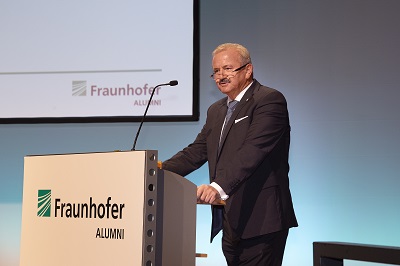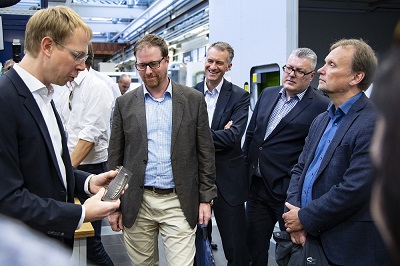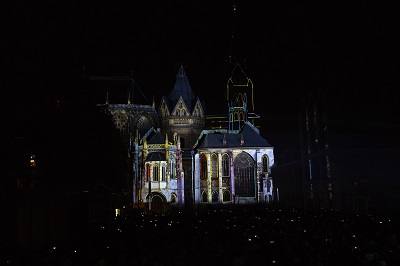Review: Fraunhofer Alumni Summit in Aachen
Fascinating presentations and top-level talks with bright minds from the academic, political and industrial sectors were on the agenda of the 3rd Fraunhofer Alumni Summit held on 28 September in Aachen. Happy to be reunited, the delegates also entered into animated discussions and creatively communicated research projects concerning additive manufacturing during the Science Slam.
The 3rd Fraunhofer Alumni Summit began with the welcome speech in front of Aachen's landmark building. Touring the cathedral, the place of Charlemagne's coronation, the delegates attuned themselves to the varied two-day event programme and the exchange of interesting ideas. The alumni gained insights into current activities at Fraunhofer during their subsequent visit to the three Aachen-based Fraunhofer institutes – the ILT, the IPT and the IME. Researchers presented the latest interesting research projects concerning laser technology, additive manufacturing and industrial plant cultivation. Excited to see one another again, the delegates saw out the first day together at Aachen's Tivoli stadium, where lively discussions ensued.
Under the influence of additive manufacturing
The key topic of the second day in the Eurogress centre was on "Additive Manufacturing" (AM). Prof. Schleifenbaum from Fraunhofer ILT presented Future AM, the request-based lead project on which six Fraunhofer institutes are collaborating to make additive manufacturing in Germany a competitive proposition. The aim is to reduce the long processing and production times of numerous metallic materials so that they can be used in series production. Prof. Reinhart Poprawe, Head of Fraunhofer ILT, later added "Future AM is set apart from other joint research projects mainly by its practical relevance, and this comes from the experience with metal garnered by the participating Fraunhofer institutes over many years".
Prof. Claus Emmelmann from Fraunhofer IAPT emphasised the importance of digital process chains in additive manufacturing. There were still too many manual activities and different file formats hindering the information flow, he said. Prof. Christoph Leyens from Fraunhofer IWS presented multi-material concepts involving AM, such as components printed on polymer films, graded materials or composite structures. Prof. Thomas Bergs from Fraunhofer IPT introduced the High-Performance Center for Networked Adaptive Production as an innovation platform for digitalisation and manufacturing, and gave other presentations as well.
In practice: Better, lighter, more cost-effective and more ecological with AM
During the panel discussion that followed, Dr Wilhelm Meiners from Trumpf, who has received multiple awards for his pioneering work in 3D printing, Dr Jens Ertel from BMW, Prof. Ingomar Kelbassa from Siemens and Peter Sander from Airbus talked about the prospects for additive manufacturing. Dr Ertel explained the benefits on a BMW Convertible component. Thanks to AM, this is 40 times more rigid, 40 times lighter, optimally adaptable and, because there is less material, cheaper than conventionally produced parts. An Airbus example was also impressive: The production of an aircraft partition by AM alone saves up to three tonnes of fuel every year.
The AM experts identified the degree of automation of the machines required to reduce the duration of AM processes, the as yet limited component size, the security of AM data and the future business models challenges for the years to come. Companies should be asking themselves whether they will continue to sell components at all or simply the data from which end users could print the components themselves.
Visit by two presidents
After the General Meeting of Alumni e.V., the Fraunhofer President Reimund Neugebauer presented to the members the new Cluster of Excellence as virtual Fraunhofer institutes, the lead projects and the most important research activities of the Fraunhofer society. He welcomed Armin Laschet, the Chief Minister of North Rhine Westphalia. The Chief Minister praised the concept of the alumni network, and also the momentum created by the Fraunhofer Institute through close collaborations with medium-sized companies for the economy, and not just in his federal state.
A brilliant finish: Aachen illuminated
The 3rd Alumni Summit drew to a close with an evening event in the city hall. The specular highlight was a 3D laser show, which told the history of Aachen Cathedral in moving images across its facade. The Fraunhofer HR Marketing Department had invited 4,000 students to the event to secure young talent for the research institute.
At the end of the day, all the delegates agreed that the event had been a complete success: most of all, they were pleased to have met with colleagues again, gained far-reaching insights into current research projects and established new and interesting contacts.
Science set on an entertaining centre stage
Once again this year, a high point of the Alumni Summit was the Science Slam, where four young scientists showcased their creative potential. The topics ranged from new bones and organs off the printer to Additive Manufacturing + Machine Learning through to 3D printing with laser and feeling. Simon Vervoort from Fraunhofer ILT, who impressed with a witty explanation of sensor integration with the help of lasagne, which included both starter and dessert, got the most laughs. Prize money of 1000 euros beckoned.
What do Fraunhofer alumni do for industry and society?
After Prof. Reinhart Poprawe from ILT had given his presentation on digital photonic production, he discussed with Personnel Director Prof. Alexander Kurz and Dr Thomas Kamps, CEO of Fraunhofer spin-off Conweaver the topic of "What do Fraunhofer alumni do for industry and society?" Prof. Kurz explained that of the 26,500 Fraunhofer employees at present, around 1,700 leave the organisation every year, 75 percent going into the economic sector, 23 percent into academia and 2 percent become self-employed. According to Prof. Poprawe, these alumni convey the Fraunhofer spirit into their new undertakings and are, of course, potential new customers, after all "business comes from talking!" The Fraunhofer alumni network is, he said, a unique platform across all sectors that benefits society as a whole.
Prof. Kurz emphasised that there was still some potential to be had: a more active alumni, mentoring programmes, support for spin-offs or even a matching platform, for instance. All these things should create momentum to further develop the Alumni Association, which currently has 720 members In response to the question about his goals for 2022, he hopes "that the alumni network continues to grow across all sectors, carries on the spirit of the Fraunhofer family to spread throughout society as a whole."


